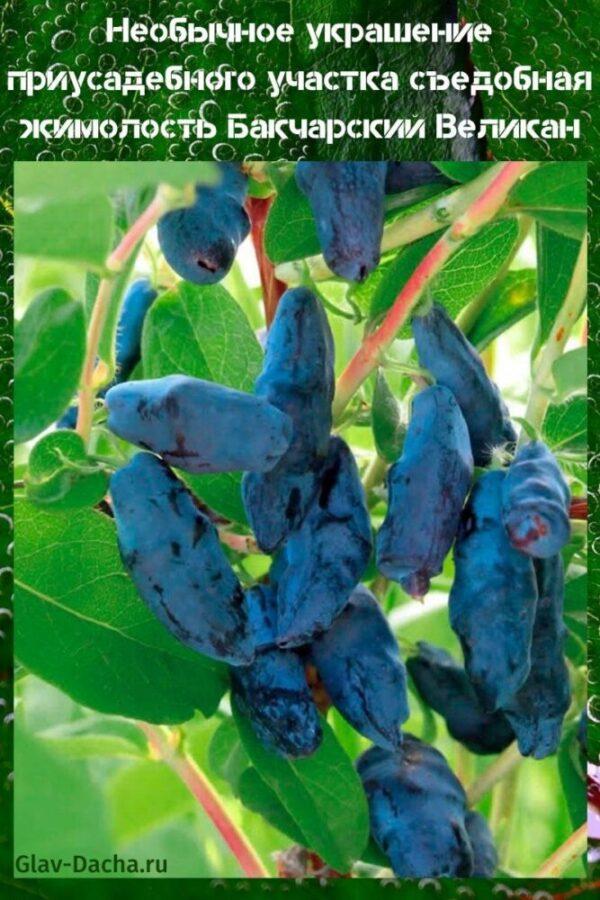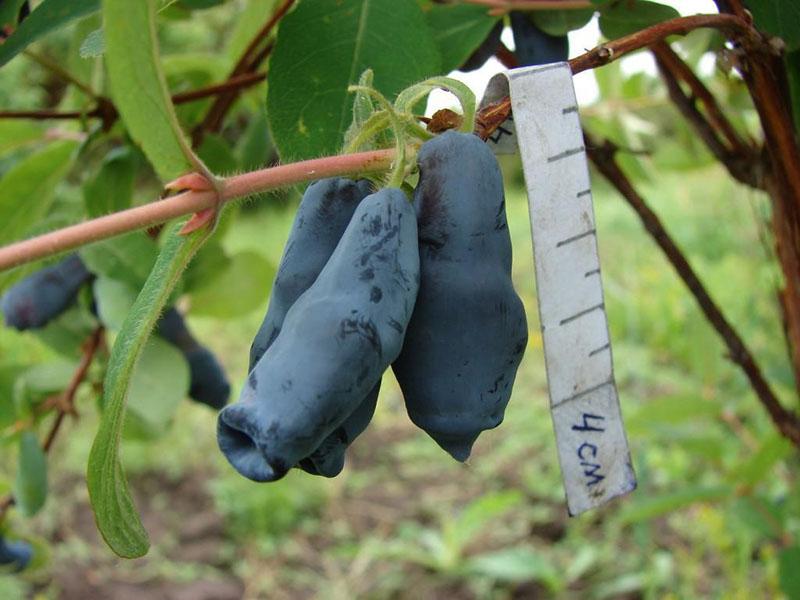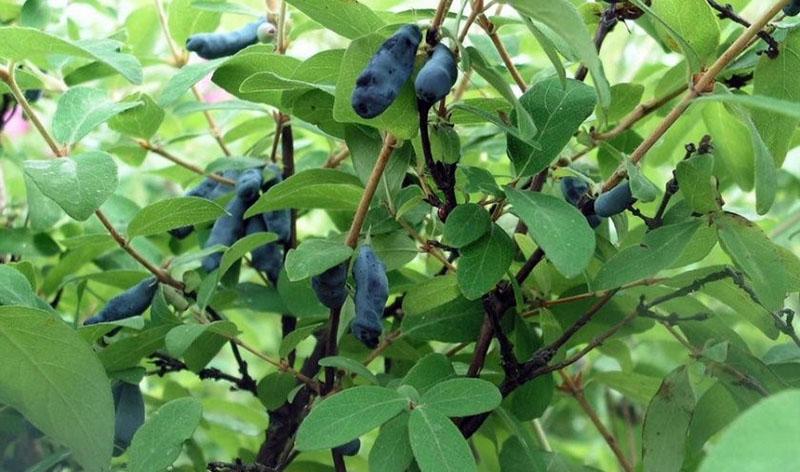Unusual decoration of the personal plot of edible honeysuckle Bakchar Giant
 Edible honeysuckle Bakchar Giant is a real "record holder" among representatives of this culture. This variety gives a rich harvest of fruits with an excellent taste, does not impose special requirements on growing conditions, and is resistant to negative weather conditions and diseases. With proper care, the Bakchar Giant successfully bears fruit for up to 15-20 years, which is why it is popular among gardeners.
Edible honeysuckle Bakchar Giant is a real "record holder" among representatives of this culture. This variety gives a rich harvest of fruits with an excellent taste, does not impose special requirements on growing conditions, and is resistant to negative weather conditions and diseases. With proper care, the Bakchar Giant successfully bears fruit for up to 15-20 years, which is why it is popular among gardeners.
Edible Honeysuckle Bakcharian Giant: Botanical Description

Description of the honeysuckle variety Bakcharsky Giant:
- Honeysuckle bushes are powerful and tall - up to 1.7-2 m in height and 1.4-1.6 m in diameter.
- The crown is spreading, oval, branches are large, massive and straight, up to 50-60 cm in length.
- The leaves are large, dark green in color with a light silvery bloom, matte surface and downy.
- The fruits are large, oblong-oval, average weight of each 2-2.5 g, length 4-6 cm.
- The berries are cylindrical, covered with a dark blue skin with a waxy coating, with a slightly bumpy surface. The pulp is juicy and tender, with small bones that are practically not felt.
- Bakchar Giant is distinguished by record frost resistance - it easily tolerates air temperatures down to -35 ° С.
Honeysuckle Bakcharskiy Giant has an average ripening period. The first crop can be harvested within 2-4 years after planting the crop - up to 3-4.8 kg of juicy and tasty fruits from each bush. Farmers harvest up to 10-13 tons of crops from 1 hectare.
 Honeysuckle inflorescences Bakchar Giant are self-fertile, and therefore they need cross-pollination. To get a rich harvest of large and juicy berries next to this bush, it is necessary to plant 2-3 other varieties of culture.
Honeysuckle inflorescences Bakchar Giant are self-fertile, and therefore they need cross-pollination. To get a rich harvest of large and juicy berries next to this bush, it is necessary to plant 2-3 other varieties of culture.
The best pollinators of honeysuckle Bakcharsky Giant are the varieties Lazurnaya, Amphora, Nymph, Pride Bakchar, Silginka, Memory of Gidzyuk.
Growing honeysuckle Bakchar Giant
 The honeysuckle variety Bakchar Giant has gained wide popularity among gardeners, because its cultivation does not present any particular difficulties. But in order to obtain a rich harvest and excellent taste characteristics of the fruits, you need to observe several nuances - choose the right planting site, soil, and also provide the plant with regular care.
The honeysuckle variety Bakchar Giant has gained wide popularity among gardeners, because its cultivation does not present any particular difficulties. But in order to obtain a rich harvest and excellent taste characteristics of the fruits, you need to observe several nuances - choose the right planting site, soil, and also provide the plant with regular care.
Site and soil selection
 Bakchar Giant is a variety that does not tolerate excessively wet, waterlogged soils. It is best to choose arid areas where groundwater is located at a distance of at least 1.7-1.8 from the soil surface.
Bakchar Giant is a variety that does not tolerate excessively wet, waterlogged soils. It is best to choose arid areas where groundwater is located at a distance of at least 1.7-1.8 from the soil surface.
Honeysuckle does not like piercing wind and drafts, so it is best to plant it under a house or outbuildings, near trees and fences.
The Bakchar Giant can be grown on almost any soil, but loamy, fertile soils are considered the most preferred. If the soil is acidic, add a pinch of ash or dolomite flour to the planting hole.
Landing dates
The optimal time for planting the Bakcharsky Giant honeysuckle variety is September or the first half of October.The plant will have time to take root by winter and will endure frosts, passing into the stage of active growth in spring. Honeysuckle is not planted in spring.
Landing scheme
 Saplings of edible honeysuckle Bakchar Giant is best bought in specialized nurseries, and not from hand. Before planting, they need to be carefully examined - there should be at least 4-5 leaves on a healthy seedling. A few hours before planting, they can be soaked in Kornevin or any other growth stimulant.
Saplings of edible honeysuckle Bakchar Giant is best bought in specialized nurseries, and not from hand. Before planting, they need to be carefully examined - there should be at least 4-5 leaves on a healthy seedling. A few hours before planting, they can be soaked in Kornevin or any other growth stimulant.
Step-by-step planting operations:
- Clean the area of weeds and fertilize with humus, peat, compost or rotted manure (10 kg per square meter).
- Dig up the soil and prepare planting holes about 50 cm deep and the same width.
- Pour a drainage layer of crushed stone, expanded clay or broken brick into the bottom of each hole.
- Add 2 tablespoons of potassium salt and superphosphate to the pits.
- Lower the honeysuckle sapling vertically into the hole and gently straighten its roots. Make sure that the root collar is located 3-4 cm above the soil level.
- Fill the holes with soil so that no voids remain in them, lightly tamp and pour in a bucket of clean, settled water.
 When planting several bushes of honeysuckle, it must be borne in mind that they grow strongly, therefore, a distance of at least 2.3-2.5 m is required between them.
When planting several bushes of honeysuckle, it must be borne in mind that they grow strongly, therefore, a distance of at least 2.3-2.5 m is required between them.
Honeysuckle care Bachkar Giant
 Proper planting and caring for the Bachkar Giant honeysuckle will ensure active growth and high yield of the plant. Abundant fruiting of the crop is ensured by regular watering, feeding, pruning, prevention and disease control.
Proper planting and caring for the Bachkar Giant honeysuckle will ensure active growth and high yield of the plant. Abundant fruiting of the crop is ensured by regular watering, feeding, pruning, prevention and disease control.
Watering
 Honeysuckle Bakcharian Giant needs systematic watering - at least once every 5-6 days. With a lack of moisture, the berries become dry and bitter. Each bush will require a bucket of standing water.
Honeysuckle Bakcharian Giant needs systematic watering - at least once every 5-6 days. With a lack of moisture, the berries become dry and bitter. Each bush will require a bucket of standing water.
No less dangerous for honeysuckle and excess moisture - this can lead to decay of the root system. Therefore, the frequency of watering is calculated depending on the weather conditions. After each irrigation, the soil around the bush must be moistened to help retain moisture.
Top dressing
 Top dressing of honeysuckle bushes is carried out in stages. The first fertilization is carried out in the spring and is aimed at increasing the fruit. For this purpose, nitrogen-containing dressings are used - ammonium nitrate gives a good effect (15 g for each bush).
Top dressing of honeysuckle bushes is carried out in stages. The first fertilization is carried out in the spring and is aimed at increasing the fruit. For this purpose, nitrogen-containing dressings are used - ammonium nitrate gives a good effect (15 g for each bush).
After the completion of fruiting, the honeysuckle bushes will help restore phosphorus-potassium supplements or a solution of nitroammofoska (13 g per 5 liters of water). In autumn, the plants are fed with manure, which is mixed with water in a 1: 4 ratio.
For each bush, you will need a bucket of prepared solution. This organic fertilizer helps to saturate the honeysuckle with nutrients and strengthen the immune system before winter.
Pruning
 Young honeysuckle bushes do not require pruning. The first procedure is carried out not earlier than 3-4 years after their planting. All frozen, damaged, dry and diseased shoots are removed. Depending on the age of the plant, up to 12-16 healthy branches should be left on the bush.
Young honeysuckle bushes do not require pruning. The first procedure is carried out not earlier than 3-4 years after their planting. All frozen, damaged, dry and diseased shoots are removed. Depending on the age of the plant, up to 12-16 healthy branches should be left on the bush.
In the process of pruning, it is also advisable to remove all branches that are noticeably bent, bent to the surface of the soil or grow inside the bush. After the procedure, all honeysuckle shoots should be evenly illuminated by sunlight - the size of the berries and their taste depends on this.
 Honeysuckle varieties Bakcharskiy Giant is a real find for gardeners living in regions with a cold, harsh climate. This plant is distinguished by record frost resistance, strong immunity to many diseases and pests, and good fruiting. With proper care, honeysuckle bushes will not only become a magnificent decoration of your personal plot, but also bring a generous harvest of tasty, large berries.
Honeysuckle varieties Bakcharskiy Giant is a real find for gardeners living in regions with a cold, harsh climate. This plant is distinguished by record frost resistance, strong immunity to many diseases and pests, and good fruiting. With proper care, honeysuckle bushes will not only become a magnificent decoration of your personal plot, but also bring a generous harvest of tasty, large berries.